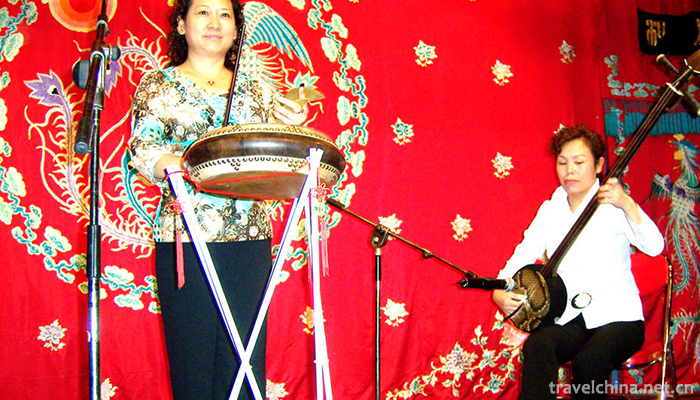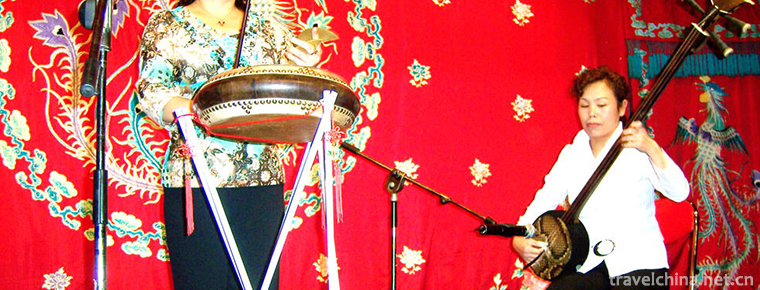Northeast drum
Northeast drum
Northeast drum was once prevalent in Shenyang, and Shenyang set up the Tianfu in the late Qing Dynasty. So it was called "Fengtian drum" in the eighteenth year of the Republic of China (1929) after Fengtian Province was renamed Liaoning Province, it was also called "Liaoning drum".
The original performance form of the Northeast Drum is that the singer sings with a small three-stringed accompaniment and ties the "festival board" to his legs. It is also called "string book". The Northeast Drum melts some tunes of Peking Opera, Jingyun Drum and Northeast Folk Songs. The tune is rich and fluent, and the expressive force of the Northeast Drum is mainly rap. The content of the Northeast Drum is mostly based on operas, novels and legendary stories. It has become a popular art.
On May 20, 2006, the Northeast Drum was approved by the State Council of the People's Republic of China to be included in the first batch of national intangible cultural heritage list with the heritage number V-6
Historical evolution
Background of origin
Originally known as Fengtian drum, Liaoning drum, there are two opinions about its origin: one is that in Qianlong period (1736-1796), a string calligrapher named Huang Fuchen came to Shenyang to present his art. On the basis of absorbing Northeast folk songs and Northeast minor, a new artistic form evolved, one singing with beating drums on a slab, the other playing three-string accompaniment, and a few books. For three or five days, more than ten days and a half months, there is another saying that the northeastern drum originated in the rural areas of Western Liaoning Province. At that time, farmers bought some small drum lyrics albums. When they were in poverty, some people used local tunes to sing them in accordance with the album. At that time, there was no radio, no television, men and women, old and young, and people sat together. Listening to the "album" was also a form of music as long as they had studied for one or two years. They can sing along the rhythm of the Ming lyrics and the new words they don't know can also be sung down. Therefore, they can know more about the folk artists who sing "song book". When they are idle in the countryside, they walk in the countryside, play three strings by hand and sing by themselves. The common people call it "TV drum". Some people in the countryside often make a living by it. Sometimes they also tell fortunes for people and criticize the eight-character Northeast University. Huo Da-wen, a drum heritor, usually takes fortune-telling as the main theme in the first month, and travels to the countryside to attend meetings. He also invites artists to tell stories and sing songs called "Music-telling Books" if there is no rain in a certain place for a long time. People wish that it will rain heavily. He also invites artists of storytelling to say passages called "Wish-telling Books", and some artists are famous, and they begin to run to the city in Daoguang (1821-1850). During the years of Xianfeng (1850-1861), there were drum-writing artists in Fengtian (Shenyang) or people who went to their hometown to present their art
Development situation
In the late Qing Dynasty (1908), the Northeast Drum became mature. With the immigration from Guannei, the Northeast countryside had been localized. The masses called it "Tu Da Gu" or "TV Da Gu". At the same time, a group of immigrants from Beijing and Shenyang came to Heilongjiang. Some of them also brought the "Fengfang School" and "Nancheng School" to Heilongjiang Province.
After the 1930s, Fengtian Drum was flourishing in Liaoning Province. Some famous actors in Fengtian Drum often went to Beijing and Tianjin to perform. Some actors also made records, which had a great impact on themselves and Fengtian Drum in the national music circle. For example, Wang Yulin, an old artist who was the forerunner to perform in Guannei, brought Fengtian Drum into China in 1910. In Tianjin, this is the flourishing development period of Fengtian Drum. In 1930, Fu Ling Ge, an old artist, led seven daughters to form Fu Jiaban into Beijing, singing short passages and performing for two consecutive years. He expanded the influence of Fengtian Drum on the Beijing Opera Circle in 1931 or so. Liu Xiangxia, known as the king of Drum Circles, performed Fengtian Drum in Tianjin, which was also praised by the audience in Tianjin. Not long after Baidai company produced records such as Baoyu Visiting the Disease and Liu Jinding Watching the Star, Zhu Ozhen, Zhu Shizhi and Zhu Yaxiang stopped to perform in Tianjin. Among them, Zhu Ozhen occupied a proper place in Tianjin music circle where she was a strong player. Victory company produced records such as "Daiyu Wangyue" and "Baoyu Crying Daiyu" for her, which were widely circulated through these actors. The performances in Beijing and Tianjin area have increased the reputation and influence of Fengtian Drum, which has greatly enhanced its popularity in the national music circle.
After 1940s, during the period of Japanese imperialist occupation of Shenyang, artists were destroyed by the tyranny and colonial rule of Japanese puppet, and gradually abandoned their Bookstore performances due to lack of food and clothing. After leaving the city, they began their homeless life, singing a few passages of books, earning some meager income and barely surviving. Fengtian Dagu entered a difficult trough stage. Since then, with the surrender of Japanese imperialism and the "recovery" of Northeast China, around 1945, the name of Fengtian Drum became more and more famous. Later, it was customarily called "Northeast Drum" from 1946 to 1948. The northern part of Northeast China was the old liberated area. With the support of the policy of the Communist Party of China, the Northeast Drum of Xiajiang School embarked on the road of revival, which was the northeast of Heilongjiang Province. During the most prosperous period of drum development, artists also developed, such as Lalin County (merged into Wuchang County in 1945) and other places. A number of influential actors emerged, such as Xia Zunpin, Shu Huanzhang, Jin Baoquan of Jiangnan School, Liu Tongxi, Sun Tongzhi, Tian Yunhai of Jiangbei School, and so on.
At the end of 1950s, the troop of performers of Northeast Drum in Heilongjiang Province has developed greatly. There are more than 60 folk Northeast Drum artists in Wuchang County alone. Most of the city and county opera troupes (folk art troupes) in Heilongjiang Province have set up Northeast Drum performers and accompanists. At the same time, some excellent actresses have emerged, such as Man Sufen of Qiqihar Opera Troupe and Wuchang County Opera Troupe. Liu Shuqing, Xia Xiuzhen of Shuangcheng County Quyi Troupe and Yang Lifang of Hegang City Quyi Troupe were all very popular in the 1960s. They have made great progress in the creation of modern theme books, such as Jiangjie Jinshan and Leifeng sung by Xia Xiaohua.
In 1966, entering the historical period of the "Cultural Revolution", this special historical period can be said to have played a heavy hammer on the development of the Northeast Drum. Like other kinds of music, the Northeast Drum was severely damaged by the "Gang of Four" cultural autocratism, and was denounced and slandered by the "Gang of Four" as "Huazi Literature and Art". It closed the bookstore, banished the actors, and the Northeast Drum withered in 1976. After the breakup of the Gang of Four, although there had been a short recovery, the original actors in Dagujie in Northeast Liaoning Province had abandoned their profession and neglected their skills, while the new generation of actors could not be produced into the 1980s. They were also impacted and influenced by the popular music of Hong Kong and Taiwan. Thus, the Dagu in Northeast Liaoning Province fell into a slump


-
1.Taipei 101 building
Taipei 101 Building, formerly known as Taipei International Financial Center
Time 2018-10-12 -
2.sate noodles
The only disciple chef Wang Daquan who teaches Shacha Noodle recipe by the master of Southern Fujian cuisine Yang Jibo inherits the tradition and makes it flourish. The main ingredients of Shacha sauc
Time 2018-11-02 -
3.The Qiaos Famaily Compound
The Qiao's Famaily Compound: National AAAAA-level tourist attractions, national key cultural relics protection units, national second-level museums
Time 2018-11-24 -
4.Xixi National Wetland Park
Xixi National Wetland Park is located in the west of Hangzhou City, Zhejiang Province. It is only 6 kilometers away from Wulin Gate, the main city of Hangzhou, and 5 kilometers away from West Lake.
Time 2018-12-07 -
5.Great Wall of Ming Dynasty in Datong County
According to documents, the Great Wall of Qinghai Province in the Ming Dynasty was built in the middle of the Ming Dynasty. It lasted 51 years from 1546 to 1596.
Time 2019-01-07 -
6.Tian Xiang Yuan
Tianxiang Garden is located in Nanchang City, Jiangxi Province, Qingshan Hunan Avenue, formerly known as the West Lake Garden. Founded in 1976, with an area of 112 mu
Time 2019-02-22 -
7.Cai Lifo quan
Cai Li Foquan is one of the Nanquan in Chinese traditional boxing. Legend has it that Chen Heng (1806-1875), a native of Jingmei Township, the new capital of Guangdong Province,
Time 2019-04-04 -
8.chanting of folk tales to the accompaniment of bamboo percussion instruments
Yugu Daoqing, also known as Bangbangqiangzi, is a kind of Han opera in Anhui Province. Beating fishing drums accompanied by singing has become a performance form of fishing drum sentiment. Fishing dru
Time 2019-07-14 -
9.Cantonese opera Yuequ
Cantonese Opera is a popular Cantonese dialect area in Guangdong and Guangxi, and has spread to Hong Kong, Macao, Southeast Asia and the Americas where Cantonese overseas Chinese live. It is a variety
Time 2019-07-16 -
10.Communication University Of China
Communication University of China ( Communication University of China Referred to as "Zhong Chuan", located in the capital city. Beijing Yes. Ministry of Education of the People's Republic o
Time 2019-12-03 -
11.juvenile Meng Ran Tik Tok Songs 2020 Hot Songs
"Juvenile" is a song composed and sung by mengran, which is included in the album "juvenile" released by mengran on November 14, 2019.
Time 2020-05-21 -
12.Administrative division of Nanchong
Nanchong City governs nine county-level administrative divisions (Municipal District 3, county-level city 1, county-level 5), and 241 township level administrative divisions (street 42, town 161, township 38). It covers an area of 12514 square kilometers and has a population
Time 2020-12-17